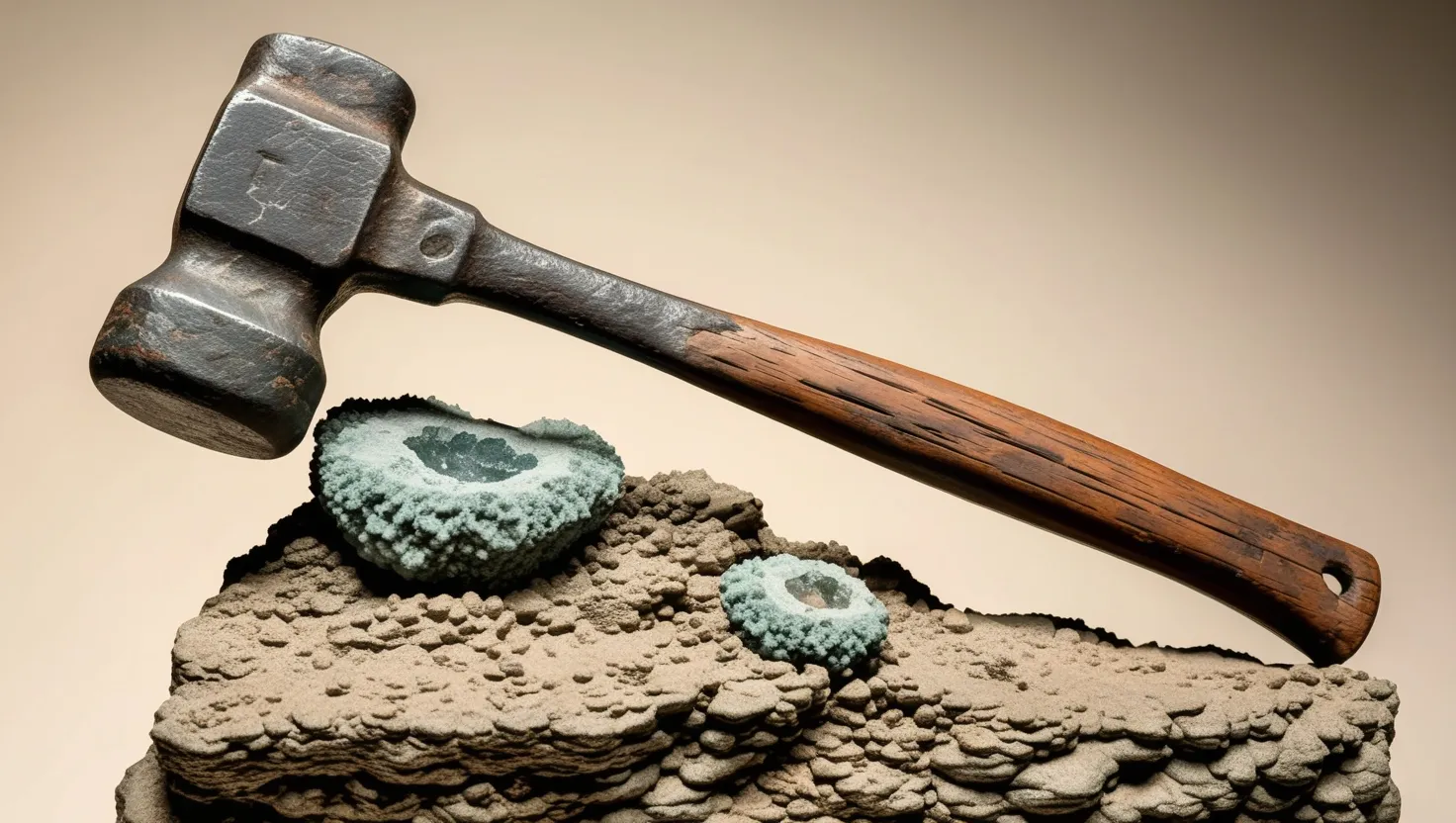It’s almost a scene made for a curious mind: a couple hiking along a sleepy creek near London, Texas, in 1936, stumble upon a lump of rock with a piece of wood poking through. They take it home as a curiosity and eventually crack it open, finding what appears to be an ordinary hammer—except this hammer’s head is encased in a solid matrix of ancient stone, apparently dating back to a time long before hammers, or even humans, were supposed to exist.
The London Hammer is no dramatic monument or precious relic. It’s a simple, six-inch tool—plain wood, iron head, a design you’d expect to see in the hand of a 19th-century miner. But its context is anything but ordinary. Geologists have linked the stone surrounding the hammer to the Cretaceous period, suggesting an age of around 100 million years. The iron head, nearly pure—96.6% iron, with only traces of chlorine and sulfur—has not rusted in almost a century since its discovery, a quality that stirs immediate interest among metallurgists and material scientists.
Now, why do I bring up something so modest as a miner’s tool in a conversation about time, technology, and the limits of scientific certainty? Because this hammer challenges boundaries. It invites not just skepticism, but a far deeper kind of curiosity about how we know what we know.
Here’s the first puzzle: Iron, in nature, doesn’t typically occur as nearly pure metal without human intervention. Most iron artifacts, from the oldest swords to present-day machinery, reveal small amounts of carbon or impurities—hallmarks of their method of manufacture. The London Hammer’s metal, for reasons unknown, lacks a clear carbon signature. It also presents minute internal bubbles, visible on X-rays, which point to a process of rapid cooling rarely seen in old-fashioned smithing. Metallurgists have struggled to replicate this purity and microstructure with today’s standard processes.
This leads us to the wood. The handle, though mostly intact, has begun a transformation known as coalification—a process by which wood turns to coal under immense pressure and heat over lengthy geological periods. Yet the handle preserves enough of its original structure to hint at a relatively gentle environment at odds with typical pressure-cooker conditions of coal production. How is it possible to have partial coalification without destroying the handle entirely?
To get the scale of this contradiction, imagine Peter’s famous principle: “For every complex problem, there is an answer that is clear, simple, and wrong.” We’re left asking: Could mineralization, the process that fused hammer, wood, and stone, happen quickly, under unusual environmental conditions? Or does the hammer’s existence point to an episode in history that we can’t easily explain?
Let me pose a question: What counts as “evidence” when an object doesn’t fit any timeline or narrative we accept? Should one artifact be enough to revise our view of history, or is it simply noise in a vast sea of data?
Detractors offer plausible explanations. Some suggest the hammer dropped into a natural cavity, flooded over time by mineral-rich water, forming a concretion only “appearing” ancient. Others propose the rock is not as old as thought, or its dating was skewed by an unusual mineral cycle. To these critics, there is no mystery, just a mistaken interpretation. Yet testing has shown mineral patterns in the matrix continuous and undisturbed, ruling out recent fissures or sediment intrusions that might indicate a modern object trapped in recent stone.
There’s also the curious absence of any known North American culture producing advanced ironwork at anything resembling this scale or time frame. Native metallurgy in the Americas did not yield forged, carbon-free iron tools. So what is this hammer doing in Texas, locked in ancient stone?
I’m reminded of Richard Feynman’s line: “Science is the belief in the ignorance of experts.” The London Hammer isn’t a call for wild speculation but stands as a reminder that gaps may exist in our models—especially when we grow too comfortable with what seems known.
What if the hammer is genuine, the rock ancient, the mineralization somehow much faster than current theories allow? Are there scenarios where mineral-rich waters, unique chemical environments, and microbial activity could catalyze stone formation in decades or centuries rather than eons? Some point to rapid petrification of organic material under very specific lab conditions, or naturally occurring phenomena in underground hot springs. Could an accidental confluence of factors in a Texas creek have distinguished this artifact with a geological speed record?
These questions don’t just jostle geologists or metallurgists. They demand that we, as curious observers, think about the stories we tell of our past. Are there blind spots in our dating methods? Are our expectations about decay and fossilization rigid enough to miss what happens during rare events? Does technological history have more “exceptions” than we admit?
Consider the hammer’s ongoing condition. Despite decades exposed to Texas’ famously humid climate, the iron head resists rust—an unusual property, even for modern tools. Is it the purity of the iron? The mineral environment of the stone matrix? Or could ancient (or accidentally postmodern) metallurgy have produced a kind of corrosion resistance we don’t fully understand?
The hammer’s story hasn’t faded into the background. It occupies pride of place at the Creation Evidence Museum in Glen Rose, Texas, a setting that itself adds another layer: Is the hammer’s display in a context committed to one worldview limiting further unbiased research that could clarify its origins? Or does it simply preserve public access to a puzzle that mainstream institutions shy away from?
Let’s not overlook the cultural side. Out-of-place artifacts, or OOPArts, often stir strong emotions. They provoke not just scientific debate but fierce claims and counterclaims about the reliability of history. Some use these objects to champion lost civilizations, even extraterrestrial visitations. Others dismiss them out of hand, defending the scientific consensus to the last stone.
There lies a deeper fascination in the possibility that our world is not as predictable as textbooks claim. The London Hammer, in its stubborn ambiguity, invites us to ask: What else might we be missing?
As Mark Twain wryly wrote, “Truth is stranger than fiction, but it is because fiction is obliged to stick to possibilities; truth isn’t.”
This isn’t about rushing to rewrite textbooks or constructing elaborate new timelines. The hammer is, above all, a test of our scientific humility. We don’t need grand theories when the everyday process of careful observation and skeptical questioning serves just as well.
So, how should I, or you, approach a relic that sits so uncomfortably between the lines of what we consider possible? Can we allow for a pause—a willingness to observe, investigate, and admit uncertainty—without needing to fill the silence with easy answers?
Throughout history, progress has hinged on those few stubborn anomalies that didn’t fit—those odd results and artifacts that stuck in the mind, prompting fresh questions. The London Hammer, in the end, serves as an invitation: not to take sides, but to keep looking, measuring, and asking what else might lie beneath our assumptions.
“Judge a man by his questions, rather than his answers.” Voltaire’s advice applies as much to old tools in Texas as it does to the big, bold claims of science.
So next time you pass a discarded hammer or an unremarkable stone, consider: How certain are you of time, of process, of history? How much do we truly know about the ticking passage of centuries and the everyday forces shaping our world? The London Hammer reminds us that sometimes, the mysteries worth pondering are hiding in plain sight.






